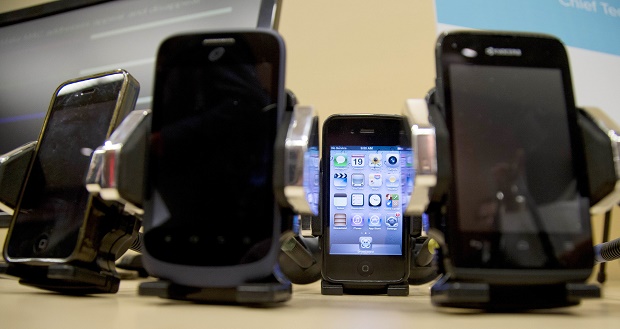
This Wednesday, Feb. 19, 2014 file photo shows a display of cell phones during a Federal Trade Commission (FTC) mobile tracking demo in Washington. On Friday, May 27, 2016, National Institutes of Health expert reviewers said they are finding flaws in the agency’s new study that connects heavy cellphone radiation to a slight increase in brain tumors in male rats. AP FILE PHOTO
WASHINGTON — A new federal study of the potential dangers of cellphone radiation, conducted in rats, found a slight increase in brain tumors in males and raised long-dormant concerns about the safety of spending so much time with cellphones glued to our ears.
But the study had enough strange findings that it has caused other federal scientists to highlight flaws in the research, and experts said these findings and those from other studies continue to suggest the potential risk from cellphone radiation is very small.
The National Institutes of Health study bombarded rats with cellphone radiation from the womb through the first two years of life for nine hours a day. It found tumors in 2 to 3 percent of male rats, which the study’s authors called low. But females weren’t affected at all and, strangely, the rats not exposed to the cellphone radiation died much faster — at double the rate — of those that were.
The results were preliminary, and only part of what will ultimately be released. They were made public before they were officially published — and despite strong criticism from other NIH scientists — because the results were similar to other studies that hint at a potential problem, said study author John Bucher.
The study is part of a seven-year, $25 million effort conducted by the National Toxicology Program at the request of the Food and Drug Administration. It looked at the specific type of radiation that cellphones transmit, called non-ionizing radiofrequency.
“This is the first study to actually show that non-ionizing radiation (causes) cancer,” said Dr. Otis Brawley, the American Cancer Society’s chief medical officer. The cancer society in astatement praised the study for “evidence that cellphone signals could potentially impact human health” but notes that it doesn’t quite address real risk to people.
“If cellphones cause cancer, they don’t cause a lot of cancer,” he said in an interview. “It’s not as carcinogenic as beef.”
He said people should be far more concerned about “distraction caused by cellphone,'” which he said causes more deaths.
Both Brawley and Bucher said this would not change how they use their own personal cellphones.
While the study found what Bucher called a likely cause of cancer in rats, he cautioned that how that applies to humans “is not currently completely worked out. This may have relevance. It may have no relevance,” he said.
Since about 1986, US brain cancer deaths have not increased or decreased, Brawley said. That suggests that whatever effect cellphones may have it is so small as to be undetectable amid regular cases of brain cancer.
Also, Brawley and others point out that cellphone technology has improved so much in recent years to emit less radiation than medical studies simulate. Bucher said the levels the rats were subjected to would be considered “heavy.”
The study also found a slight increase in a very rare type of heart tumors in the male rats exposed to cellphone radiation. The same NIH scientists looked at mice, but those results won’t be ready until next year.
Some of the study’s own reviewers had trouble accepting the results because of the odd factors, such as rats in the group that wasn’t exposed didn’t contract what would be the normal number of brain tumors for that population.
“I am unable to accept the authors’ conclusions,” wrote outside reviewer Dr. Michael Lauer, deputy director of NIH’s office of extramural research. “I suspect that this experiment is substantially underpowered and that the few positive results found reflect false positive findings.”
The fact that the rats exposed to radiation survived longer than those that weren’t “leaves me even more skeptical of the authors’ claims,” Lauer wrote. Four other study reviewers — three from NIH — also raised questions about the way the study was conducted and its conclusions.
Bucher said he couldn’t explain that strange factor, nor could he explain why females were not affected. Brawley said it could be the female hormone estrogen is offering some cancer protection as has been seen in some other cancers.
George Gray, a risk and environmental health expert at the George Washington University School of Public Health, said one key part of the study is not the data itself, but how it is being interpreted. And he said the study seems to focus on the small increase in tumors in males, not the absence of them in females “and does not reveal the level of scientific uncertainty in applying these data to people using their phones.”
If people are truly worried, they should use Bluetooth or headsets, Brawley said.
In 2011, a working group of the International Agency for Research on Cancer said cellphones are possibly carcinogenic. But numerous studies over the years, before and after that listing, have found little evidence of a problem. Among the largest, a survey of 13,000 people in 13 countries found little or no risk of brain tumors, with a possible link in the heaviest users that the study’s authors found inconclusive. And a large Danish study that linked phone bills to a cancer registry found no risk even in longtime users.
READ: Does prolonged cell phone use cause brain tumors?
Gray said a study like this needs to stand up to challenge and fit in with other research.
“This is a high profile topic that hits close to home for most of us,” Gray said in an email. “It is really important to realize that a single study like this does not provide ‘the answer.'”
RELATED STORIES Cell phone use may cause cancer —WHO
TV, cellphones leading causes of vision loss—study